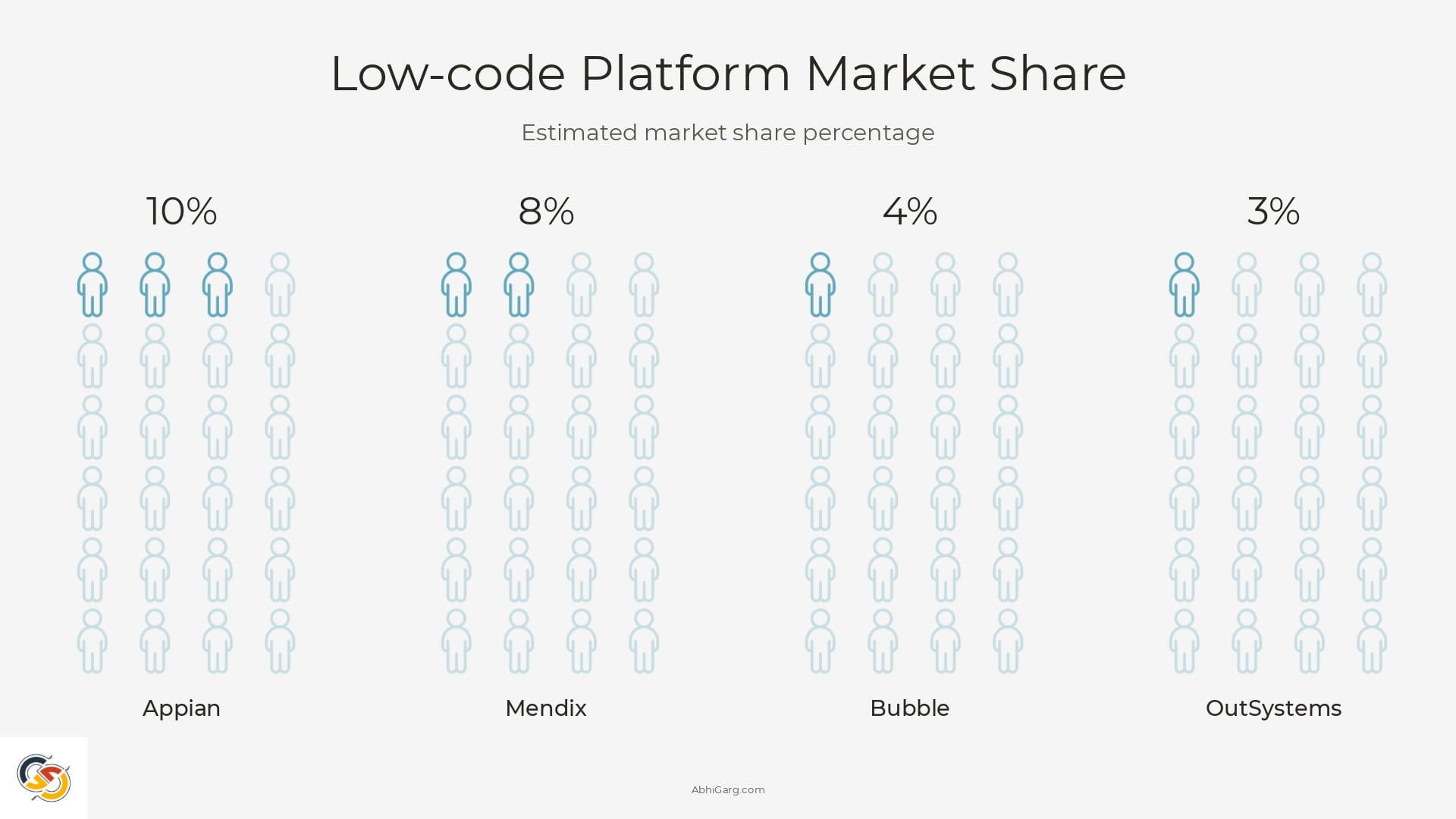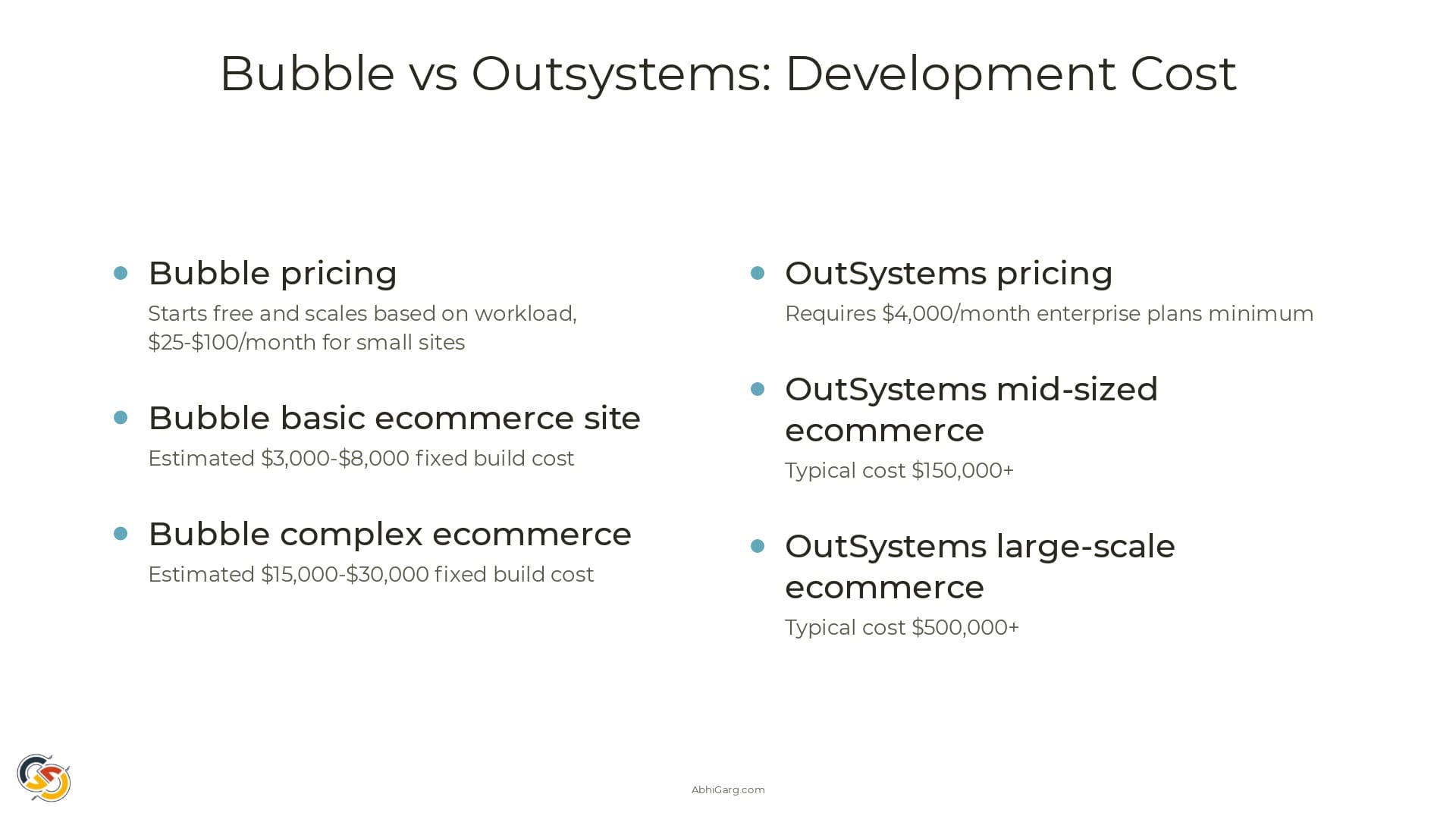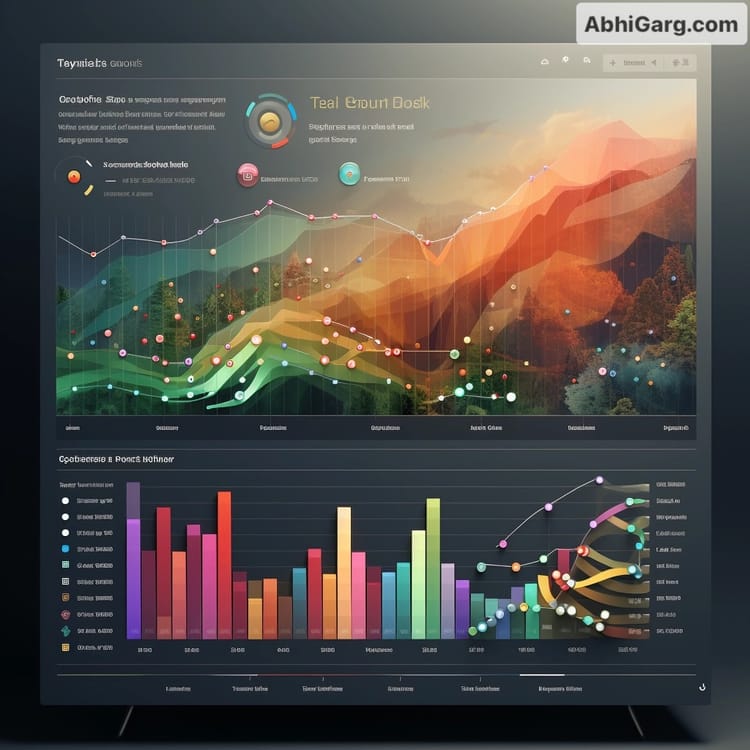Bubble.io vs. OutSystems - Which is the better low-code / no-code app development platform?

OutSystems and Bubble.io are both popular platforms for developing web and mobile applications. They are known as low-code or no-code platforms, enabling users to build applications with little programming experience.
Here are 7 key differences between the low-code platforms Bubble.io and OutSystems:
| Factor | Bubble.io | OutSystems |
|---|---|---|
| Learning Curve | Steeper learning curve scaling complexity | Faster initial onboarding |
| Frontend Focus | Prioritizes UI customization and pixel-perfect designs | Constrains some frontend flexibility |
| Backend Capabilities | Can require more manual workflow logic coding | Specializes in encapsulating backend complexity |
| Integrations | Core database and API options built-in | More seamless enterprise integrations |
| Scalability | Best for smaller scale web/mobile apps | Built for large enterprise-grade workloads |
| Pricing Model | Usage-based pricing, affordable for individuals | Upfront enterprise plans required |
| Key Customer Base | Startups, SMBs, entrepreneurs | Large enterprises, IT organizations |
- Bubble.io favors greater front-end design flexibility for customizable consumer-focused apps.
- OutSystems focuses more on large-scale enterprise backend complexity, integrations, and scalability.
- The optimal platform depends on the specific priorities and needs of the app use case.
Introduction
The no-code revolution promises to transform application development by eliminating the need for specialized coding expertise. Two leading platforms enabling anyone to build robust web and mobile apps with drag-and-drop simplicity are Bubble and OutSystems. Both provide visual development environments that empower productivity. However, Bubble and OutSystems take divergent architectural approaches tailored to different priorities.
In this in-depth comparison, we’ll unpack how Bubble offers greater front-end design flexibility for custom interfaces while OutSystems focuses more on streamlined back-end logic integrations. Bubble enables elaborately customized user experiences, and UI flows for consumer-centric apps. OutSystems efficiently incorporates complex backend data workflows, third-party API integrations, and performance-intensive enterprise workloads.
You'll gain perspective on their complementary strengths by evaluating their differences across usability, functionality, extensibility, scalability, and costs. The optimal platform choice depends mainly on the complexity of backend logic, scale needs, and UI personalization requirements intrinsic to your web or mobile application vision. Let’s analyze where Bubble and OutSystems diverge to best inform your no-code platform decision-making.
Bubble Overview
Bubble was founded in 2012 by Emmanuel Straschnov with a vision to transform complex app development into a completely visual, code-free process usable even by non-developers. The web-based Bubble platform allows anyone to build full-fledged web and mobile applications entirely through an intuitive drag-and-drop interface without writing code.
At its core, Bubble offers a robust front-end design canvas for crafting custom user interfaces with pixel-perfect precision down to colors, layouts, animations, and every interaction detail.
Bubble handles translating elaborately customized UIs into production-ready code behind the scenes. The platform also provides integrated database creation and management for content and user data flows with simple diagramming of application logic workflows.
Bubble is optimized for maximum design flexibility, allowing new and existing entrepreneurs to iterate constantly on delivering creatively rich, personalized user experiences catered to their target audience. The focus centers on crafting beautifully designed, consumer-friendly interfaces tied to customized workflows rather than large-scale backend complexity. Everything from landing pages to multi-layered web apps to mobile extensions can be developed visually via Bubble's interface without a single line of code.
Outsystems Overview
OutSystems was founded in 2001 to enable rapid application development through visual, low-code abstractions of traditional coding. The company progressed to pursue an ambitious “no-code” platform, allowing large enterprises to build mission-critical apps, workflows, and integrations purely through drag-and-drop visual modeling.
OutSystems excels at neatly encapsulating immense backend complexity into modular, easily managed diagrams representing logical data architecture. Integrations with external databases, legacy systems, APIs, and cloud infrastructure can be streamlined into efficient new applications.
The visual models auto-translate into optimized code handled entirely by OutSystems.
While providing baseline UI templates and components, OutSystems focuses less on elaborately customizable front-end experiences and prioritizes large-scale behind-the-scenes logic. Whether it’s core business process workflows, intricate data harmonization across siloed platforms, or UI data flows, OutSystems allows enterprises to scale complexity exponentially while lowering their workload.
The system manages the entire application lifecycle, from automated cloud provisioning to one-click deployments and maintenance. OutSystems suits large IT organizations where the priority lies more in seamlessly bridging complex backend infrastructure than crafting elaborately customized consumer-facing interfaces. Their strong suit is unlocking back-end agility through flexible, scalable, and reliable no-code abstractions.

Ease of Use Comparison between Bubble.io and Outsystems
Regarding no-code platforms, ease of use is pivotal in empowering broad productivity by abstracting away specialized technical skills. Bubble and OutSystems aim to minimize learning curves but approach simplicity differently.
Bubble is built from the ground up for anyone to start building web or mobile app ideas instantly without prior web development know-how. The homepage greets new users with an immediate option to start a blank new project in the visually intuitive editor. Every aspect uses simple drag-and-drop construction, from wireframing user interface screens to defining workflows, integrations, and database architecture. Complexity gets tucked neatly behind user-friendly diagrams.
Minimal technical vocabulary and ample starting templates lower barriers to swiftly designing full-working apps. Bubble's rich design-focused tooling makes structuring elaborate multi-page interfaces with custom animations and interactions intuitive.
However, handling highly sophisticated enterprise-grade applications with scores of dynamic data touchpoints can require substantial design architecture within Bubble. Unavoidable learning curves scale to exponentially complex logic workflows spanning vast databases, external services, and legacy platforms. New developers may outgrow Bubble’s constraints when pursuing cutting-edge interfaces leveraging advanced functionalities.
In contrast, OutSystems deliberately constraints some degrees of front-end customization flexibility in favor of zero-friction back-end complexity abstraction. The platform uses uncommon terminology but provides extensive materials to smoothly onboard developers and business teams. While modeling intricate logical integrations and workflow architectures requires unavoidable specialized learning, OutSystems offers robust patterns and templates to streamline construction even at a tremendous scale. By hiding infrastructural clutter like cloud provisioning or dependencies behind simple diagramming, OutSystems simplifies challenges holding back large IT organizations. However, those seeking fine-grained influence over end-user experiences may need more than UI customization options.
Functionality Comparison between Bubble and Outsystems
Bubble and OutSystems take divergent approaches regarding front-end customizability versus back-end complexity. Bubble gives developers unmatched open-ended control to customize multi-page user interfaces with precision to fine-grained details. OutSystems deliberately constrains some front-end flexibility in favor of streamlined integration of intricate back-end logic and external services.
Bubble provides an exceptionally robust frontend canvas for crafting unique interfaces. Developers can leverage various pre-made UI widgets and templates while retaining pixel-perfect control over customized CSS, animations, transitional effects, colors, layouts, and every micro-interaction. Support for multi-page applications with complex junctions, shared elements, nested navigation, and advanced interactivity empowers rich front-end experiences.
Creators can leverage Javascript snippets for heightened functionality. However, extensive UI customization causes tradeoffs - substantial design architecture is needed when handling highly sophisticated enterprise application requirements.
Conversely, OutSystems uses integrated UI elements like forms, lists, and buttons that remain uniform across applications. Customizing individual UI components deeply requires working around some constraints. However, the uniformity allows OutSystems to focus heavily on streamlining complex backend workflow logic integrations. Using robust visual diagram patterns, even tremendously sophisticated multi-step processes across databases, cloud infrastructure, and external APIs get neatly encapsulated to reduce workload. OutSystems shines for enterprises needing to capture complex business logic flows under integrated architectures. API integrations and database operations see point-and-click ease, enabling intricate yet cohesive data environments.
Bubble and OutSystems provide mobile support, user authentication, hosting configuration, and baseline workflow templates for built-in tools. However, OutSystems includes more advanced enterprise-focused capabilities out-of-the-box, like role-based access control, robust caching, and pre-built connectors to many systems. Bubble offers more breadth across over 750 front-end widget variants, 10,000+ UI templates, and diverse design assets.

Cost Comparison between Outsystems and Bubble IO
Bubble and OutSystems take substantially different pricing approaches that reflect their target customer segments. Bubble offers a free tier covering core functionality to allow small teams and individuals to build essential apps at no cost. Paid plans ranging from $25 to $475 monthly provide additional cloud workload capacity and active user support suitable for commercial applications. Any extra features like advanced database additions or hosting require separate costs.
Bubble pricing correlates closely with application complexity, spanning pricing variables like compute usage, storage needs, and workflow triggers. Bubble can enable full-functioning applications that are entirely free for small projects, but costs scale up directly with production burdens. No pricing cap exists; however, unlimited scaling is enabled for workloads.
In contrast, OutSystems only provides paid plans targeted to large enterprises and avoids hobbyist users. Their pricing starts at $90 monthly for sandbox testing needs and extends up to $4,000 and beyond monthly for unlimited mission-critical workloads. Even at low tiers, OutSystems includes its complete range of features and cloud infrastructure. The high-end plans allow enterprise customers to build extensively complex applications with vast data flows to mass consumer audiences while only paying for hosting resource burdens, not functionalities. Support and maintenance are also bundled, while Bubble charges extra.
So Bubble follows a pay-per-use model tailored to cost-conscious creators with apps that do not need enterprise capacity. OutSystems gives enterprises upfront pricing covering extremely intensive workloads matching their serious reliability and support needs at tremendous economies of scale.
Conclusion and Recommendations
In summary, Bubble is optimally suited for small, agile teams rapidly building web or mobile apps focused on customized user experiences, creative interfaces, and consumer-friendly design. The expansive front-end tooling and iterative flexibility empower startups and businesses to constantly refine apps catering to their target users.
Conversely, OutSystems best serves large enterprises needing to integrate complex backend processes involving intricate data environments and workflows spanning APIs and existing infrastructure while scaling apps to immense workloads. OutSystems abstracts infrastructural complexity for IT organizations whose priorities lie more with functionality than interfaces.
So consider Bubble for consumer-centric projects where pixel-perfect UIs, rapid iterations, and design uniqueness are crucial.
OutSystems is preferred when backend complexity, enterprise legacy platform integration, and large-scale reliability take priority over front-end specialization.
Ultimately, both platforms continue advancing no-code capabilities in complementary directions. The optimal choice depends primarily on whether UI specialization or backend flexibility is more intrinsic to an organization’s application needs and scaling challenges.
No-code app development unlocks unprecedented productivity, which Bubble and OutSystems both tap into. However, each applies that empowerment to differing strengths. By understanding their nuanced tradeoffs, development teams can best leverage these visual platforms based on project contexts and use case priorities.
FAQs
- What Are the Key Advantages of Using OutSystems for Enterprise Software Development?
- OutSystems is a high-productivity platform tailored for enterprise-level application development.
- It offers a visual development environment with extensive customization and flexibility.
- The platform supports robust integrations with various systems and databases.
- Advanced features include AI-assisted development, top-notch security, and scalability.
- While it has a steeper learning curve and requires a subscription, OutSystems is ideal for large-scale projects needing long-term support and advanced features.
- How Does Bubble.io Benefit Small Businesses and Startups in App Development?
- Bubble.io is a user-friendly, no-code platform perfect for individuals without programming skills.
- Its visual, drag-and-drop interface simplifies web application building, focusing on ease of use and rapid prototyping.
- While offering a range of plugins and integrations, Bubble.io remains more accessible and affordable than OutSystems.
- The platform's gentler learning curve and free plan options make it a go-to choice for small businesses, startups, and entrepreneurs looking to test ideas quickly in the market.
- When should you choose OutSystems over Bubble.io for app development?
- Opt for OutSystems when dealing with large enterprises or complex business processes that require advanced customization, integration, and enhanced security.
- OutSystems is the better choice for scalable projects and those that demand long-term support and a higher development budget.
- Conversely, choose Bubble.io for small-scale projects, especially for users with no technical background and limited budgets, focusing on rapid prototyping and MVP development.



